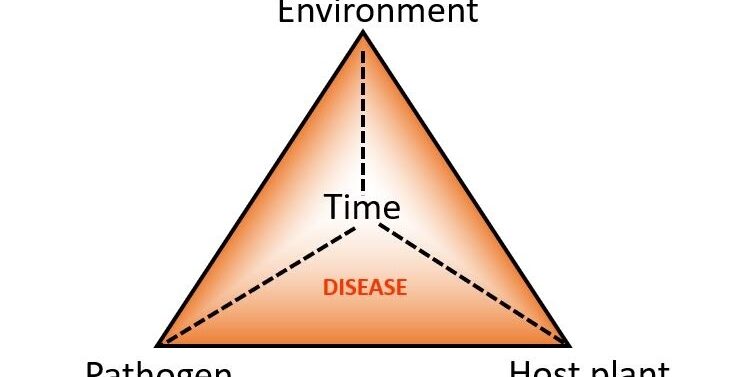Ring a ding ding! …Hear that? It’s dinner time!
That’s the disease triangle, the backbone of disease, and without a complete triangle—no dinner for tree pathogens.
But first, what is “disease” exactly? Disease is simply any change from the normal functioning of a tree. Disease can be ongoing and, depending on the situation, can eventually lead to total tree death.
Understanding of the disease triangle is the first step to making sure that your trees have the opportunity to live a long and fulfilled life. Let’s take a look at the three “courses” of the disease triangle.
First, we need a susceptible tree. All trees are susceptible to diseases, some more than others. Likewise, certain varieties of trees are more tolerant of some diseases than others. For example, American elm trees are far more susceptible to Dutch elm disease than their relatives the Siberian elm.
Second, we need a vigorous pathogen. Pathogens are microscopic and can be bacteria, fungi, or viruses. Odds are, the pathogens are already creeping around your Madison area urban forest! The three types have varying infection methods:
- Fungal pathogens travel through the air as tiny spores and seek out cuts and natural openings in trees.
- Bacteria typically move through wind and rain and can be moved from tree to tree through pruners that are not properly disinfected, or intertwining root systems.
- Viruses are typically moved from tree to tree through pruning (proper pruning by a Madison area Certified Arborist is a must!), or intertwining root systems.
Third, the last point on the triangle, is environmental conditions that favor pathogen infection and disease development. To be fair, there are a lot of tree pathogens out there that are favored by all sorts of environmental conditions. But generally, cool and wet conditions favor infection of trees while hot and dry favor disease development.
Lastly, and most important, when all of these factors interact, the disease takes time to infect and develop. Catching disease early in its development provides the best chance of saving your tree. You have the chance to influence that crucial factor: time. If your trees are looking suspect, call ECO Tree Company, your Madison area tree service, for an expert evaluation before your disease triangle is complete.
Example of a common tree disease:
Dutch Elm disease
Tree: American Elm
Caused by: Fungus Ophiostoma ulmi, moved by elm bark beetles
Symptoms: leaf yellowing, wilting, and eventual drop
General Diagnosis: fungicide macroinjection by ECO can combat the fungus







